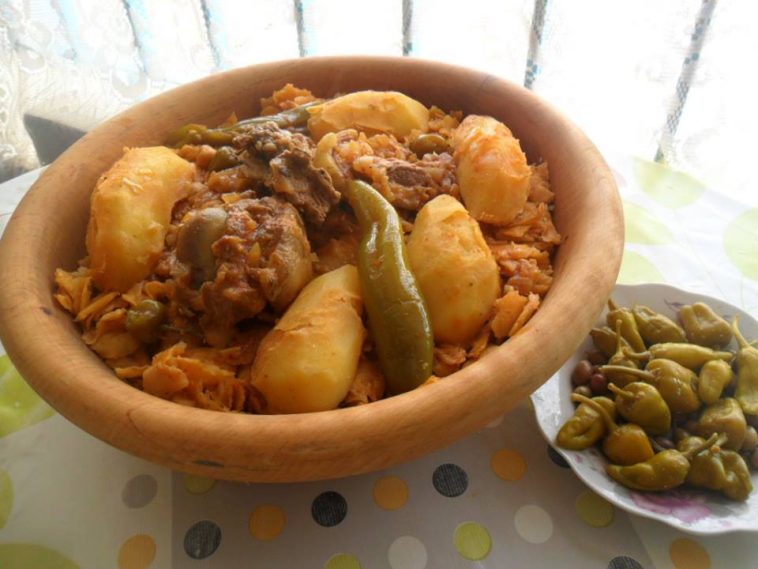In the middle of the twentieth century, La Maison Arabe was the most famous restaurant
on the African continent. A French woman and her daughter opened it in 1946, after the
pasha Thami el Glaoui granted them the right for the first restaurant in the medina open
to foreigners and provided one of his chefs. Frequented by Winston Churchill, Charles
de Gaulle, Queen Ingrid of Denmark, and Jackie Kennedy, La Maison Arabe remained a
legendary, essential dining spot until the mesdames shuttered it in 1983. Fabrizio Ruspoli,
an Italian-French aristocrat who spent much time during his childhood in Tanger, purchased
the property in 1995 and converted it into Marrakech’s first boutique hotel. Over
the years, the food has regained its prominent place, and the kitchen is once again the
finest in the city.
This sophisticated tagine from the La Maison Arabe kitchen, using the trademark mixing
of sweet and savory, and drawing on the citrus groves around Marrakech, is guaranteed
to impress. Sublime.
LAMB TAGINE WITH
ORANGES, SAFFRON,
AND CANDIED
ORANGE PEEL
SERVES 4
1 tsp butter, softened
1 tsp ground ginger
1⁄2 tsp ras el hanout (see page 52)
1⁄2 tsp ground cinnamon
1⁄2 tsp turmeric
1⁄4 tsp freshly ground white pepper
Generous 1 pinch saffron threads
Salt
2 Tbsp olive oil
21⁄4 lb/1 kg bone-in leg of lamb, cut into
8 or so pieces
1 small cinnamon stick, broken in half
1 medium red onion, finely chopped
2 Tbsp fresh orange juice
1 tsp honey
1 Valencia orange, scrubbed
1⁄4 cup/50 g sugar
8 cloves
1 tsp toasted sesame seeds for garnishing
In a tagine, flameproof casserole, or large, heavy
skillet or sauté pan, add the butter, ginger, ras el
hanout, cinnamon, turmeric, white pepper, and
saffron. Season with salt. Moisten with the olive
oil and blend well. One by one, place the pieces
of lamb in the spice mixture, and turn to coat.
Add half of the cinnamon stick and scatter the
onion across the top.
Place the tagine over medium heat, cover,
and cook, turning the lamb from time to time,
until the meat is browned and the onion is softened
but not scorched, about 15 minutes. Add
1 cup/240 ml water, loosely cover, and cook over
medium-low heat for 45 minutes, stirring from
time to time. Add B⁄c cup/120 ml water and 1 Tbsp
of the orange juice and cook until the meat is
tender, about 45 minutes. Add a bit more water
if necessary to keep the sauce loose, or remove
the lid to evaporate and thicken it. Stir in the
honey and cook the lamb uncovered for a final
5 minutes.
Meanwhile, peel the orange, reserving the
fruit. With a knife, scrape away some—but not
all—of the white pith from the peel. Cut the peel
into long, very thin strips about B⁄i in/3 mm wide.
In a small pan, bring B⁄c cup/120 ml water to
a boil. Add the strips of peel and a pinch of salt,
and simmer for 2 minutes. Drain, discard the
liquid, and rinse out the pan. Return the strips
to the pan, cover with D⁄e cup/180 ml water,
and bring to a boil. Stir in the sugar and add
the remaining cinnamon stick and the cloves.
Simmer until the liquid is syrupy and the strips of
peel are tender but still a touch al dente, about
20 minutes. Stir in the remaining 1 Tbsp orange
juice, remove from the heat, and let cool.
With a sharp knife, cut away any white pith
from the reserved orange. Carefully cut along
the membranes separating the segments and
remove them. Lay the segments in a shallow
bowl, spoon the syrup from the pan over the
segments, and let soak until ready to serve.
To serve, divide the lamb among four plates,
and top with the sauce, orange segments, and
strips of caramelized peel. Lightly sprinkle with
the sesame seeds.
